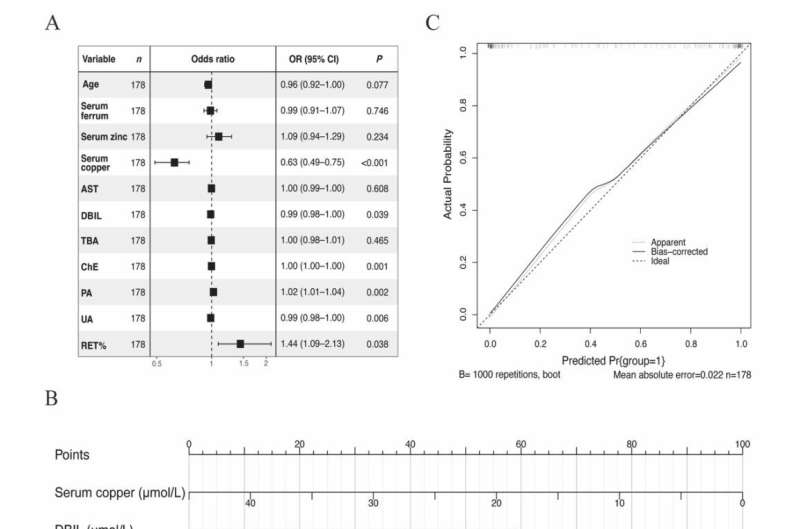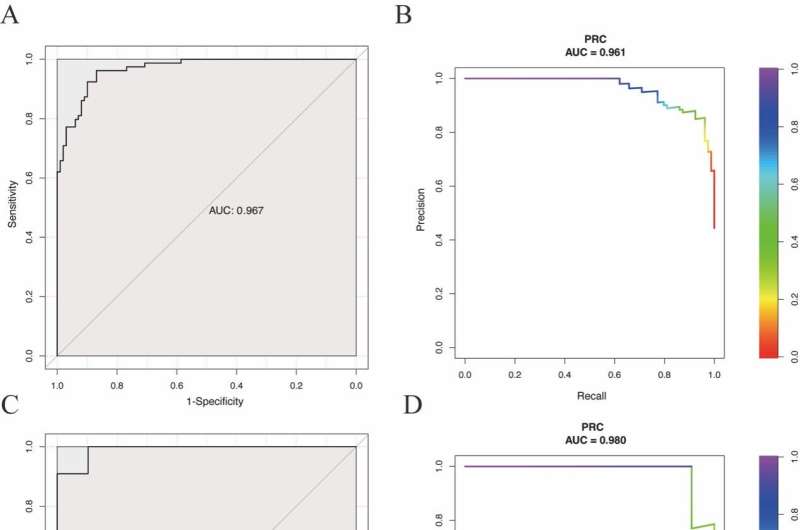This article has been reviewed according to Science X's editorial process and policies. Editors have highlighted the following attributes while ensuring the content's credibility:
fact-checked
proofread
Novel nomogram based on routine clinical indicators for Wilson's disease detection

Wilson's disease is a rare autosomal recessive disorder characterized by abnormal copper deposition in the liver, brain, cornea, and other tissues. It can lead to severe symptoms such as hepatitis, cirrhosis, and liver failure or neurological manifestations such as tremor and dysarthria.
In China, however, this disorder is much more common due to lack of screenings for early diagnosis; tests like serum ceruloplasmin, 24-hour urinary copper excretion, Kayser-Fleischer rings, hepatic copper content and gene sequencing are not frequently conducted.
In a study published in Liver Research, a research team based in China developed a simple nomogram based on easily accessible and automatable detected routine clinical indicators to reduce missed diagnosis and misdiagnosis of Wilson's disease.
The study included 90 Wilson's disease patients with abnormal liver function and 128 patients with similar liver function but without Wilson's disease. Twelve candidate indicators were selected from the routine clinical indicators in the training cohort based on a selection operator regression analysis and the least absolute shrinkage. The indicators were then entered into a multivariate logistic regression model.
"We identified six independent predictors of Wilson's disease: serum copper, direct bilirubin, uric acid, cholinesterase, prealbumin, and reticulocyte percentage," said Jiahui Pang, lead author of the study. "Based on these routine clinical indicators, we constructed a novel nomogram for Wilson's disease."

Xinhua Li, co-corresponding author further explained, "The training cohort's nomogram revealed a strong area under the receiver operating characteristic curve of 0.967 (95% confidence interval (CI) 0.946–0.988), demonstrating excellent recognition. The optimal cut-off point for the nomogram was 213.55, with 96% sensitivity and 87% specificity."
Validation of the model in the cohort produced an even more impressive area under the receiver operator characteristic curve of 0.991 (95% CI 0.970–1.000). Decision and clinical impact analyses were then carried out on the model to underscore its high clinical value.
"We constructed an accurate nomogram for Wilson's disease and found it had an excellent diagnostic efficacy," added co-corresponding Yongyu Mei. "A notable advantage of this nomogram is that the six routine blood indicators used in its construction can be obtained easily through noninvasive methods."
Indeed, this novel model enables earlier detection of Wilson's disease compared to serum ceruloplasmin and 24-hour urinary copper tests. It could help pave the way for clinicians in making targeted decisions and increasing the diagnosis rate of Wilson's disease.
More information: Jiahui Pang et al, A novel nomogram based on routine clinical indicators for screening for Wilson's disease, Liver Research (2023). DOI: 10.1016/j.livres.2023.02.003





















